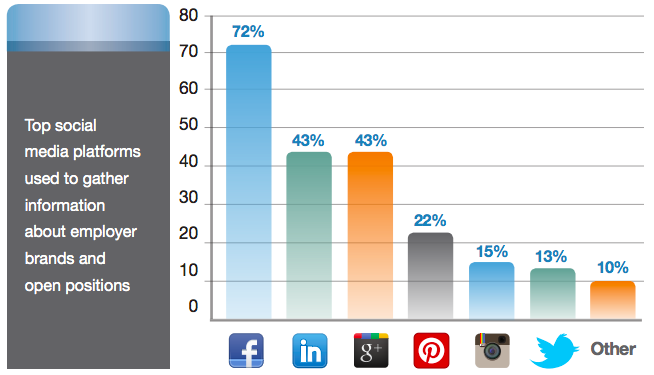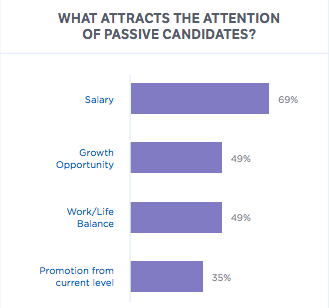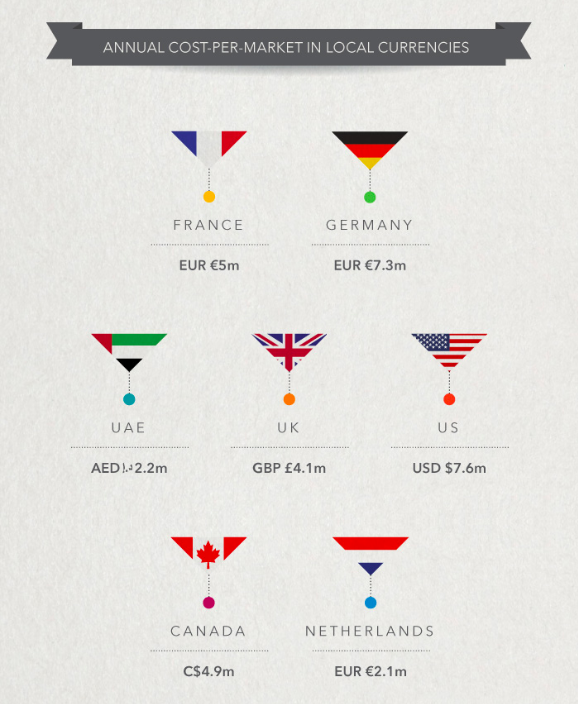
What are the Benefits of Employer Branding (Recruitment, Cost-savings, Performance, and more)
HR Tips Stefan Kingham
Back in 2004, a Google search of the term “employer branding” would have yielded 3000 hits. Today that number is well over 2 million.
Employer branding is quite evidently gaining greater strategic importance with each passing day, but what’s it all about exactly?
Put simply, employer branding is the way your company is perceived by potential new employees, or in other words, your organization’s reputation as an employer.
An employer branding program includes all strategies that aim to improve your company’s external and internal reputations, enhance your organizational attractiveness and boost your company’s capacity to retain its best talents.
Why should you care about employer branding?
Before we dive into the actual benefits of employer branding, here are some interesting insights regarding the current popularity of employer branding among HR professionals and middle market executives:
- 72% of recruiting leaders worldwide believe that employer branding has a significant impact on hiring.
- 79% of middle market executives agree that a strong employer brand is essential to their ability to attract top talent.
- 55% of global recruiting leaders have a proactive employer branding strategy.
- 59% of recruiting leaders worldwide are investing more in employer branding.
- 2/3 of recruiters anticipate that employer branding will increase in importance at their organizations in the next 12 to 24 months.
As illustrated by the aforementioned statistics, having an effective employer branding strategy is becoming increasingly important in today’s competitive landscape.
Your employer branding strategy can be the difference between hiring the developers you need or losing them to your competition, and the financial benefits of investing in a strong Employee Value Proposition are plentiful.
Save money on recruitment
There are recruiters and marketers out there who trick themselves into believing that employer branding is but a HR fad leading to superficial results and wasted time and money.
But while investing in employer branding may seem like an excessive time commitment at first, the significant returns it generates make it a reliable and necessary investment.
1. Lower Cost-Per-Hire
A strong employer brand fosters a great work environment and makes your brand more attractive to potential candidates. This in turn means that your employees will be more inclined to refer your organization to other professionals and that you may have a ready-made talent community from which to draw from.
Look at it this way: if you’ve worked on developing a strong brand image and job seekers are naturally attracted to your company, you’ll most probably spend less money creating awareness for your job openings. Instead, you might just post your job opportunities across your company’s social media channels.
And if you can count on your employees to convey a positive image of the company and refer you to job seekers, you’re bound to spend way less on advertising and the such.
In actual fact, candidates generated through referrals are the 2nd cheapest means of sourcing and more and more job seekers admit they use social media platforms to gather information about employer brands and open positions.

Source: https://manpowergroup.com
Bottom line: According to Linkedin, companies that invest in employer branding experience a 50% cost-per-hire reduction.
2. Faster Time To Hire
By investing in employer branding, you’re able to attract more talent. And companies that can attract more talent can also hire that talent faster.
One of the main benefits of having a strong employer brand is that you’ll have a larger and better talent pool from which to fill vacancies. Basically, this means you’ll be able to spend less time selling and more time closing candidates.
Think about it from a sales perspective. It’s a well known fact that inbound leads convert at a much higher rate than cold calls, right? Well it’s the same for talent acquisition!
Bottom line: Companies that invest in employer branding are up to 2 times faster when it comes to filling vacancies.
3. Lower Employee Turnover
Alright so there are two ways this works.
On the one hand, having a strong employer brand allows you to attract qualified applicants. And usually speaking, you want to keep your best assets, meaning you won’t be replacing them anytime soon.
And on the other hand, if you create a bond with prospective employees before and during the recruitment process (as well as the onboarding process), you’re encouraging those future employees to have a high level of engagement with the company.
And as we all know, more engaged staff means increased productivity, higher company morale and lower employee turnover.
Bottom line: According to Linkedin, companies that invest in employer branding experience a 28% decrease in staff turnover.
4. Savings on Salaries
While it’s certainly a very important factor, top talent candidates seek more than just an attractive salary.
Let’s say that a positive employer brand encompasses 5 main qualities:
- Job security.
- More professional development opportunities.
- Opportunity to work on a better team.
- Organization with same values as candidate.
- Organization that is talked about positively by present and past employees.
A company that manages to reunite all 5 qualities mentioned above is going to be able to offer candidates something more than just attractive wages.
In other words, investing in employer branding gives you a competitive advantage AND enables you to hire top talents without necessarily having to break the bank.
Here are some interesting insights from the US to back up this argument:
- Companies with all 5 of the qualities encompassing a positive employer brand can attract 46% of full-time US workers without any pay increase.
- 40% of passive candidates would be willing to move without a pay increase if an organization had most of the qualities of a positive employer brand.
- 38% of younger professionals (18 to 34 years old) would be willing to accept a reduction in pay in order to work in a company with a positive employer brand.
Help attract qualified candidates
As significant as the financial benefits of employer branding may be, the underlying purpose of improving your organization’s reputation as an employer is to be seen by more candidates and attract the top talent on the market. This in turn leads to increased productivity and reduced hiring costs of course, but it all starts with making your organization as attractive as possible to job seekers.
1. Attract Passive Candidates
Before we ask ourselves to what extent employer branding can help you to attract passive candidates, let’s make sure we all agree on what a passive candidate actually is.
So basically, passive candidates are people who are already employed and who aren’t currently looking for a job. They represent 60% of the workforce and are generally more desirable for recruiters seeing as they’re more likely to be motivated by a potential new role for the ‘right’ reasons.
So how can employer branding help you to attract more passive candidates?
While offering a higher salary is generally the most effective way of attracting passive candidates, having a strong employer brand provides your organization with more selling points with which to pull them in.
Passive candidates could be just as tempted by a company that offers better growth opportunities or a healthier work/life balance, once again underlining the potential impact of investing in employer branding.

Source: http://www.middlemarketcenter.org
2. Visibility = Trust
Did you know that 75% of job seekers consider an employer’s brand before even applying for a job?
In other words, no matter how interesting the role you’re trying to fill may be, you’ll never attract the right candidates if people struggle to find information on your company or if you have a poor online reputation.
In actual fact, the number 1 obstacle talents experience when searching for a job is not knowing what it’s like to work at an organization.
By investing in employer branding, making sure your website has a dedicated careers page, building a community on your social media platforms and encouraging your current employees to share their own experiences online, you’re giving candidates the information they crave and making your brand significantly more attractive.
Candidates tend to trust a company’s employees 3 times more than the company to provide credible information on what it’s like to work there, which is why it’s so important to encourage high levels of staff engagement.
3. Talent Retention
It’s important to keep in mind that a strong employer brand is good for attracting potential candidates, but also for retaining your best assets.
As previously explained, leveraging employer branding to create a bond with prospective employees before and during the recruitment and onboarding process can go a long way towards retaining key employees.
Improve company performance
In essence, the idea is that people who have a positive perception of your brand may be more likely to buy your products and services, and vice-versa.
Look no further than Apple for instance. We all remember the employee scandal that came out a few years ago and the negative impact that had on their business growth.
Having an employer brand that is focused on your people translates well to social media and other outlets where your customers interact, and the process of investing in employer branding builds a bridge between talent acquisition and driving revenue.
Not convinced? We’ll let the statistics do the talking:
- 71% of middle market companies with a clear and effective employer brand reported improved company performance in 2017, compared to 45% of firms with less developed employer brands.
- Organizations with strong employer brands saw revenues grow by 20% and workforce grow by more than 12% in 2017.
- Firms with weaker employer brands experienced just under 8% growth in revenues and only 4.4% employment growth.
What are the dangers of ignoring employer branding?
If you ignore employer branding, you’re basically refusing to acknowledge that your company’s reputation is an important factor in a candidate’s job search process.
You therefore risk losing top talents to your competitors, not being able to retain your best assets and spending far too much on recruitment.
As a matter of fact, 50% of workers say they wouldn’t work for a company with a bad reputation, even with a pay rise.
Furthermore, employers who fail to invest in their reputation could be paying up to an additional $4,723 per employee hired (data related to American organizations) and the overall cost of a bad reputation for a company in Germany with 10,000 employees could be as much as €7.3 million in additional wages!

Source: https://business.linkedin.com
Seeing how beneficial it can be in the long run, enhancing your company’s reputation and actively encouraging employees to participate in your employer brand should be an absolute no-brainer.
And since 68% of HR managers in 2018 say they’re having difficulties hiring, up from 50 percent in 2013, it might be time for recruiters to improve their game and start investigating how to reach more quality candidates.
Embracing employer branding is a great place to start.
Sources:
Linkedin’s Ultimate List of Employer Brand Statistics
Hudson: How to Launch a Successful Employer Brand
NCMM: Building the Top Team
Linkedin: The Real Cost of a Poor Reputation







